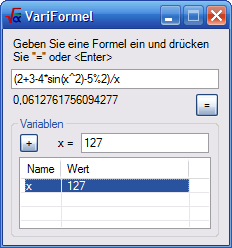
Introduction
Have you ever wondered how Microsoft Excel solves its formulas? This here is your way to get your own, personal and fast formula interpreter. It is used in products such as:
- VariPlot - 2D Graph plotter
- VariPlot3D - 3D Surface plotter
- VariComplex - Fractals visualizer
Background
If you are writing a formula interpreter, you should decide which technology you want to use. As you might expect, there are lots and lots of possibilities to do this. I decided to do it recursively, because this offers a very easy way to use delegates, translate it into unmanaged C++, or add special functionality such as differential- and integral calculations.
Using the code
Using the interpreter is very easy:
- Initialize a new interpreter instance.
private VariFormel fml=new VariFormel();
- If needed, add some variables. The chars
a, b, c, d, e, f, g, h, x, y are allowed variable names. Variable names can only consist of one char. VariFormel.Variable var=
new VariFormel.Variable("x",127.0);
if (!fml.NeuV(var))
MessageBox.Show("Variable name not allowed");
- Pass a string value to interpret.
double res;
if(!fml.Neu(tbFormel.Text,out res))
{
MessageBox.Show("Formula invalid");
}
else
lblResult.Text=res.ToString();
How it works
The magic of the interpreter lies in a function called Zuteilung, which takes a string, analyzes it, and returns a number value, if the string is interpretable. If the string contains more than one command, the function calls itself recursively to get the rest of the string interpreted.
There are different types of commands which a string can contain:
- the string is wrapped in brackets, e.g., (x*2) => you have to remove all outer opening brackets and their corresponding closing brackets.
- the string is a constant, e.g., PI or EU => you have to return the value of the constant.
- the string is a variable, e.g., a, b, c ... x, y => you have to return the value of the variable.
- the string is a single-parameter function, e.g., sin(x*2) => you have to return the function of the recursively called value.
- the string contains an operator, e.g., 2+3-4 => you have to return the last operation with the rest called recursively.
- the string contains rubbish => return 0.0.
private double Zuteilung(string Op)
{
if (Op.Length==0) goto fehl;
if (Op.StartsWith("(") &&
GetKlammer(Op,0) ==Op.Length-1)
Op=Op.Substring(1,Op.Length-2);
if (double.TryParse(Op,
System.Globalization.NumberStyles.Float,
null,out res))
return res;
if (Op.Length==2 && Op=="PI") return Math.PI;
if (Op.Length==1 && TryVariable(Op,out res)) return res;
if (Op.Length>4 && Op.Substring(3,1)=="(")
{
pos=GetKlammer(Op,3);
if (pos!=Op.Length-1) goto next;
zc=Op.Substring(4,pos-4);
switch (Op.Substring(0,3))
{
case "sqr":return Math.Sqrt(Zuteilung(zc));
case "sin":return Math.Sin(Math.PI*Zuteilung(zc)/180);
case "cos":return Math.Cos(Math.PI*Zuteilung(zc)/180);
case "tan":return Math.Tan(Math.PI*Zuteilung(zc)/180);
case "log":return Math.Log10(Zuteilung(zc));
case "abs":return Math.Abs(Zuteilung(zc));
case "fac":return Faculty(Zuteilung(zc));
}
}
next:
pos=0;ebene=6;klammer=0;
for (int i=Op.Length-1;i>-1;i--)
{
switch (Op.Substring(i,1))
{
case "(":klammer++;break;
case ")":klammer--;break;
case "+":if(klammer==0 && ebene>0){pos=i;ebene=0;}break;
case "-":if(klammer==0 && ebene>1){pos=i;ebene=1;}break;
case "*":if(klammer==0 && ebene>2){pos=i;ebene=2;}break;
case "%":if(klammer==0 && ebene>3){pos=i;ebene=3;}break;
case "/":if(klammer==0 && ebene>4){pos=i;ebene=4;}break;
case "^":if(klammer==0 && ebene>5){pos=i;ebene=5;}break;
}
}
if (pos==0 || pos==Op.Length-1) goto fehl;
zc=Op.Substring(pos,1);
string t1,t2;
t1=Op.Substring(0,pos);
t2=Op.Substring(pos+1,Op.Length-(pos+1));
switch (zc)
{
case "+":return Zuteilung(t1)+Zuteilung(t2);
case "-":return Zuteilung(t1)-Zuteilung(t2);
case "*":return Zuteilung(t1)*Zuteilung(t2);
case "/":return Zuteilung(t1)/Zuteilung(t2);
case "%":return Math.IEEERemainder(Zuteilung(t1),Zuteilung(t2));
case "^":return Math.Pow(Zuteilung(t1),Zuteilung(t2));
}
fehl:
fehler=true;
return 0.0;
}
When analyzing operator strings, you have pay special attention:
2+3-4-2 => you have to interpret it as ((2+3)-4)-2
To do this, you have to go through the formula from the back, and give the operators signs:
Then calculate the lowest sign operator, and you get a kind of a tree. But you have to take care about the brackets => you can only interpret the outer level of the formula:
2+3-(4-2) => you can't interpret the subtraction in brackets by now
Also, there is the problem of picking the right one of the wrapping brackets:
(3+2+4)+sin(x) => if you take the last bracket, it's wrong,
you have to take the one after +4.
Therefore, you have to write a function to find the matching bracket always:
private int GetKlammer(string Op,int start)
{
int res=start;
for (int i=start;i<Op.Length;i++)
{
switch (Op.Substring(i,1))
{
case "(":klammer++;break;
case ")":klammer--;break;
}
if (klammer==0){res=i;break;}
}
return res;
}
The function increments a variable called klammer on every opening bracket, and decrements it on every closing bracket, and if its value reaches 0, it has found the corresponding position.
Furthermore, you have to decide if the string is a variable and then return its value. VariFormel uses two arrays for doing this, one double[] array for the values, and a string value for containing the names.
The allowed array is used for determining if the value name is suitable.
private string vars="";
private const string allowed="abcdefgxyz";
private double[] values=new double[10];
private bool TryVariable(string Op,out double wert)
{
int i=vars.IndexOf(Op);
if (i!=-1)
{
wert=values[i];
return true;
}
else
{
wert=0.0;
return false;
}
}
The function is called by the main function.
The rest of the VariFormel class is used to provide a nice, easy to use code-structure, here only the main parts are explained.
For more information, see the source code itself.
Points of Interest
Unless I think it's very useful, this is just the beginning point of a formula interpreter. Just go forward and modify it to fit your personal needs. For example, the recursive procedure can easily be updated to use delegates, which is up to 4000 times faster and very good for iterational calculations (function plotters etc.). There is already a delegate-version working in VariPlot Reload.
If you translate VariFormel into C++ or make any other modifications, I would be glad if you would drop me a mail so I can see how VariFormel evolves.
Have fun with the code :-)
